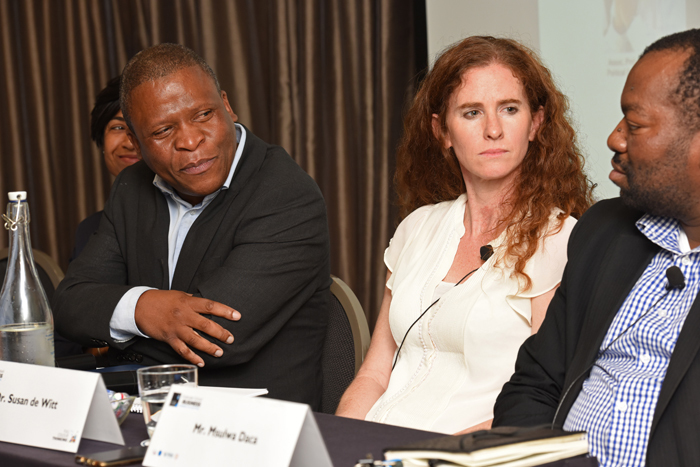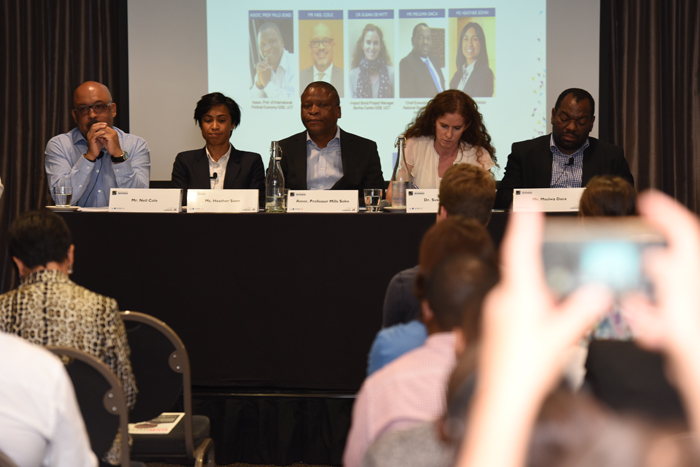Social impact bonds lead solutions for HE funding
17 November 2016 | Story by Newsroom
Current funding models will not solve the higher education sector's funding crisis. But social impact bonds can provide an interesting financing mechanism to fund “wrap around” support for the country's poor and 'missing middle' students − and to ensure that students accessing higher education receive an equal opportunity to succeed.
This is the view of Dr Susan de Witt, senior project manager of innovative finance at the Graduate School of Business's Bertha Centre for Social Innovation and Entrepreneurship.
She was speaking at the 11 November GSB round table discussion on higher education funding. Facilitated by the GSB's director-designate, Associate Professor Mills Soko, her co-panellists were Heather Sonn (Gamiro Investment Group), Msulwa Daca (CEO National Student Financial Aid Scheme, or NSFAS) and Neil Cole (Collaborative Africa Budget Reform Initiative).
“First and foremost, this involves the provision of additional grant and loan funding from an array of donors and investors to cover full tuition and accomodation costs essential to enable access,” De Witt explained.
She said social impact bonds (SIBs), which are outcomes-based contracting mechanisms, may prove to be an effective way of incentivising institutions to provide the additional academic and psychosocial support that is crucial to student success.
“Social impact bonds are a way of financing outcomes-based contracts where payments or returns are made according to success against those outcomes-based contracts,” she explained.
The ministerial task team on higher education funding appointed the Bertha Centre to investigate alternative solutions, and their work on social impact bonds is “both innovative and promising,” De Witt said.
“While NSFAS is distributing up to R14 billion a year, if you want to cover the whole missing middle cohort, you need to raise R60 billion a year. It's unsure what the appetite is at national level to be providing that entirely as a grant. So investigations have been on assessing the feasibility of raising private funding.”
Novel financing mechanism
The bulk of the task team's work has been on establishing a government structure to provide funding to cover students' accommodation, tuition and books. But even this is inadequate, De Witt said. Getting students across the line is a more complex challenge and requires additional investment in their academic and psychosocial support to improve graduation rates and reduce dropout rates.
“There's a strong realisation across the board that providing financial assistance is not sufficient to enable students to maximise their potential. Students come to universities under-equipped from the basic education system; they are overwhelmed by the different cultures; they are not academically prepared, nor do they have the literacies to be able to pass their courses. What this means is that access is not opportunity for them.”
What is being mooted is an additional financing structure to pay for academic and psychosocial support.
“We have to determine whether is it feasible to achieve this through the novel financial mechanism of social impact bonds,” said De Witt.
“You identify an outcomes-based funder; in this case it might be public sector or private donors. If the goal is to increase graduation rates, they set up an outcomes-based contract with a service provider; in this case the institutions themselves. There are external service providers like the Michael and Susan Dell Foundation or Thuthuka Bursary Fund, REAP [Rural Education Access Programme], etc, but most of the support comes from within the institutions.
“And the outcomes-based contract stipulates that if those institutions increase graduation by an agreed amount such as five percent or 10 percent across the board – or it could apply to specific faculties or degrees, we don't have an answer to that yet – then the outcomes funder will pay them. The institutions themselves would therefore need to provide this kind of support in the absence of upfront funding. So they'd need to be able to raise working capital from socially motivated investors.”
Burden of protests
 Assoc Prof Mills Soko, director-designate of the Graduate School of Business (middle) facilitated a round table discussion on higher education funding. The panellists are (from left) Neil Cole, Heather Sonn, Susan de Witt and Msulwa Daca.
Assoc Prof Mills Soko, director-designate of the Graduate School of Business (middle) facilitated a round table discussion on higher education funding. The panellists are (from left) Neil Cole, Heather Sonn, Susan de Witt and Msulwa Daca.
De Witt's co-panellists added their perspectives on the funding crisis.
Daca said that NSFAS is at the coalface of the debate on higher education funding and that the fee-free protest rhetoric was causing the organisation some headaches.
NSFAS is not just a loan fund, he said. Seventy percent of its funds, R14 billion this year, is disbursed as bursaries and only 30 percent as loans. Students who receive these loans are required to repay half of the money. However, expectations of free education were hampering loan recovery.
“We're worried that we might actually lose traction. [Some] hope free fees might be declared retrospectively,” he said.
Daca noted that the change in the protest dynamic, moving from traditionally disadvantaged to better-resourced institutions, which ask higher fees than the R72 000 cap per student, also suggested a bigger problem.
“Even if a student is fully funded by NSFAS, they might still have debt at these universities … and this is probably one of the drivers of the current situation.”
Free education is not free
Cole's 'back of the envelope' calculation of what free higher education would cost the country was sobering: R85 billion to R150 billion, but “more towards R150 billion”, he added.
“This would make it the country's highest single expenditure: more than is spent on social grants, more than basic education and more than health. Is this right in terms of current priorities and spending pressure?”
The short answer was no. Instead, government, the private and public sectors had to tackle the problem more creatively in order to get financially and academically vulnerable students across the line.
“Budgeting is about trade-offs,” said Cole. “Increasingly, it's not about moving money from defence to higher education, but from health into education and vice versa. And both are equally important priorities.”
Basic education was an even bigger crisis looming “just around the corner”, said his co-panellist Sonn. She said that three million children entered the school system each year but only 500 000 emerged at the end. And only five percent of these young adults get to university.
Elephant in the room
It didn't take long for the elephant in the room to emerge and dominate discussions from the floor: government corruption.
Government had to fix its “leaky buckets” one participant said. These are the poorly performing state-owned enterprises (South African Airways, Eskom, et al), corrupt activities that drained billions from the fiscus, and inefficiencies such as ministries that duplicate work. All combined to reduce fiscal manoeuvrability to little or nothing.
Suggestions from the floor included boosting vocational training in an era of high youth unemployment (when even graduates struggle to find jobs), making UNISA free (the distance-learning institution absorbs one-third of the country's students), monetising universities' knowledge and assets, and creating university-run businesses, like call centres employing students.
But all is not doom and gloom.
Sonn said that she had been heartened by the good news stories emerging from the engagements, citing UCT's School of Economics' open sessions where faculty, students and interested parties got together to debate and think creatively about the problem.
“They were engaging the stakeholders in actively seeking solutions,” Sonn added. “[We must] include people at the margins in the solutions. We need to find each other.”
As Soko said at the start, the stakes for the country are high and the issue is compounded by transformation, decolonisation and institutional culture in higher education institutions.
“But we want to apply our minds to the issues at hand.”
Most important, he said, is “the role the university ought to play to achieve our national development goals and the models we'll need to put in place to achieve that.”
Story Helen Swingler. Photo Michael Hammond.
 This work is licensed under a Creative Commons Attribution-NoDerivatives 4.0 International License.
This work is licensed under a Creative Commons Attribution-NoDerivatives 4.0 International License.
Please view the republishing articles page for more information.










